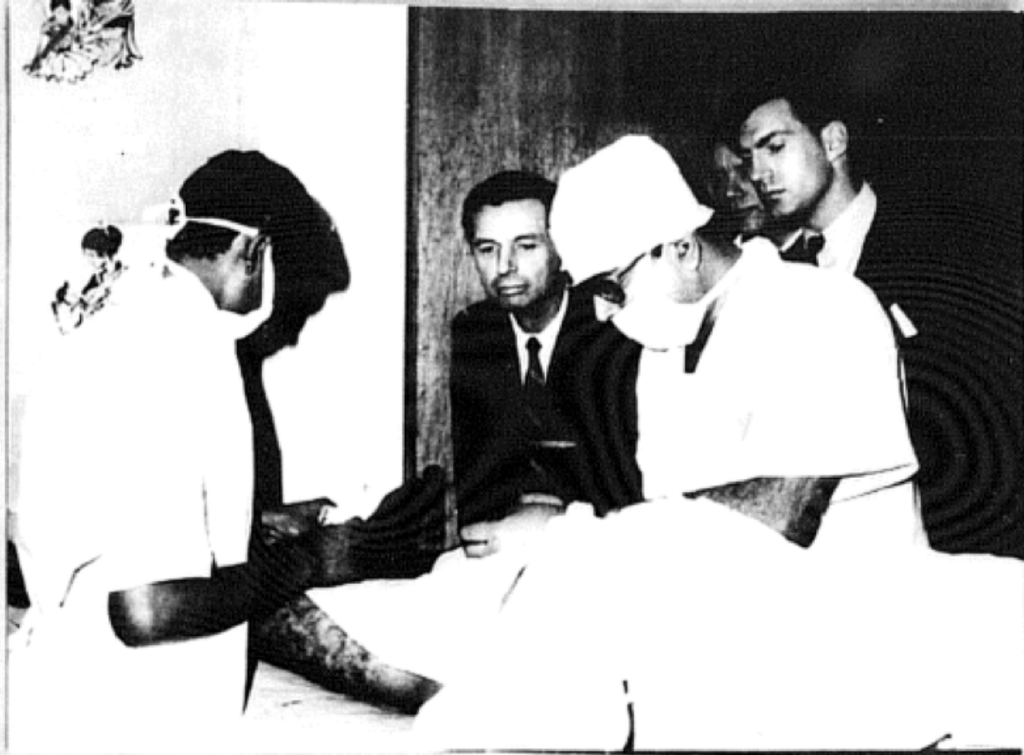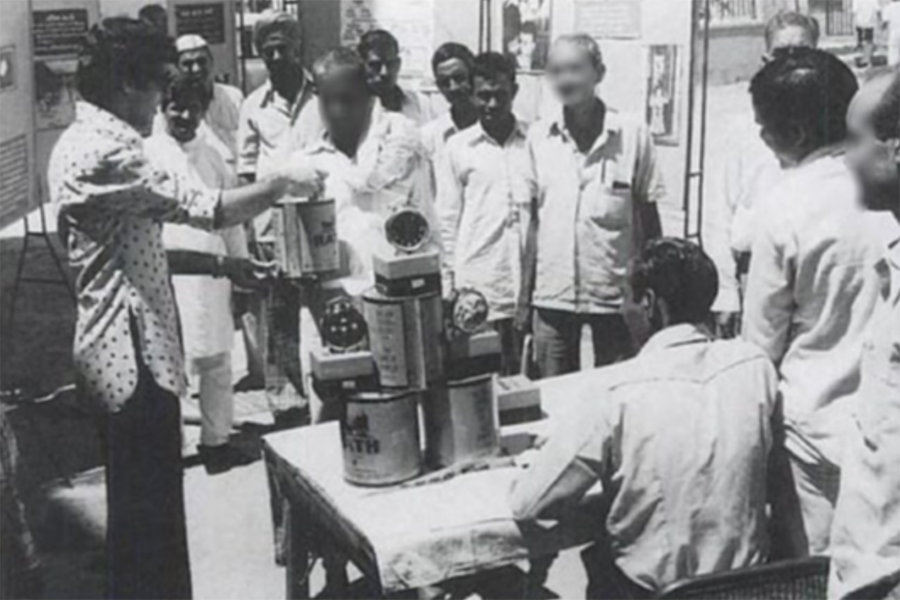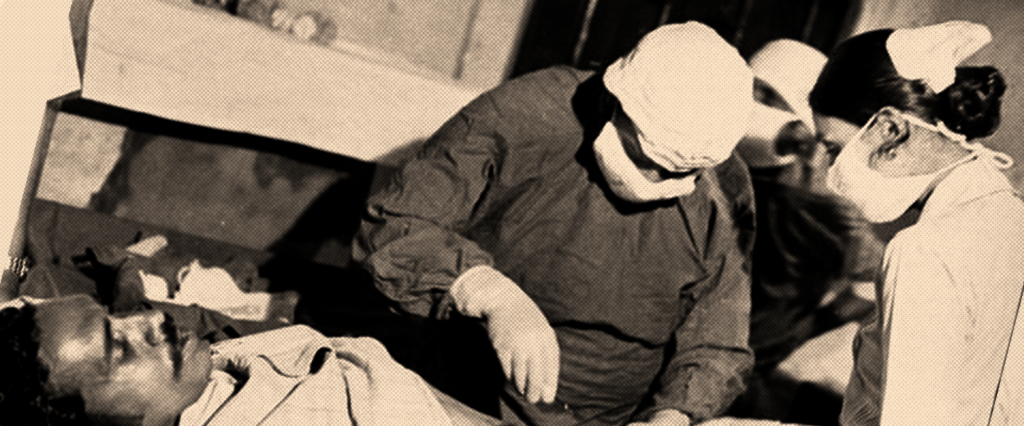The loudspeakers began blaring at 3 a.m. on November 24, 1976, in the rural village of Uttawar, 50 miles south of New Delhi. When 34-year-old Mohammad Yaqoob heard hooves approaching, he huddled with eight villagers in their compounds. It was the ghoda police (policemen on horses), warning them of the consequences of noncompliance.
Sterilization was no longer a choice — it was a mandate.
Every man over the age of 15 was directed to assemble at a high school on the main road. For the past year, senior government administrators and police officers had been attempting to convince male villagers with more than two children to get a vasectomy. But in a country where being a man was defined by his virility, sterilization was a tough sell. Numerous misconceptions associated with vasectomies didn’t help. Some people believed the procedure caused death on the operating table; others thought they’d lose weight — or worse, their sex drives. To combat these fears, posters that extolled the pragmatism of family planning were hung throughout the village. Their messages read: “With one, two or three kids, you’ll have a happy house. Fewer kids means more food for each. Greater the number, more the hunger.”
A year earlier, Prime Minister Indira Gandhi had declared a national emergency because of what she deemed an “internal disturbance.” In fact, Gandhi was in danger of losing power, having violated multiple election laws, and the courts were closing in. Meanwhile, India was weathering a perfect economic storm: Food production had fallen thanks to below average rainfall; an international crisis had increased the price of imported oil; and inflation was at an all-time high. “[Gandhi] knew she had to take charge and did a lot of things through brute force,” explains Pallavi Banerjee, Assistant Professor of Sociology at the University of Calgary who studies gender and masculinity in the Indian families, who tells me this was Gandhi’s way of demonstrating that even though she was a woman, she was still tough. “It’s also interesting to me that all of these vasectomies were done under a woman’s leadership.”

She was happy, however, to share authority with Sanjay Gandhi, her ambitious, yet inexperienced, youngest son, who despite having little knowledge of how the government functioned, played a critical role in the mass sterilization campaign that would lead many to regard the emergency period as “The Dark Age of Indian Democracy.” In particular, the younger Gandhi was convinced population control was essential for India’s economic development, and so, he argued family planning should be a way of life. It was hardly a novel concept, though. More than one million men were sterilized in India in 1971, and a little more than three million were sterilized just two years later in 1973 — neither, of course, inconsequential numbers. What set apart the Gandhis’ effort, however, was the sheer size and aggressiveness of their program, with 6.1 million men being snipped in 1976 alone.
Per usual, all of this is best understood with some additional historical context. Namely: In 1951, four years after India gained independence from Britain, the nation’s first census revealed a decidedly grownup problem — the population had reached 361 million, and the state’s lead urban demographer, R. A. Gopalaswami, estimated that number would grow by 500,000 every year, garnering the attention of an increasingly environmentally-conscious global community. Meanwhile, India faced a critical food shortage in the early 1960s. This gave rise to apocalyptic visions of mass starvation reminiscent of the kind Stanford University professor Paul R. Ehrlich warned about in his book, The Population Bomb. The opening scene of Ehrlich’s gratuitous cautionary tale hardly served to tamp down such hysteria, painting a less than flattering portrayal of a ride he and his family took “in an ancient taxi, its seats hopping with fleas” through a crowded Delhi slum:
“The streets seemed alive with people. People eating, people washing, people sleeping. People visiting, people arguing and screaming. People thrust their hands through the taxi window, begging. People defecating and urinating. People clinging to busses. People herding animals. People, people, people, people. Since that night, I’ve known the horror of overpopulation. The battle to feed humanity is over, and humanity has lost.”
Attempting to sidestep an overpopulation apocalypse, the World Bank loaned India’s family planning program tens of millions of dollars to implement a crash sterilization program. The international push was so extreme that in 1965, President Lyndon Johnson refused to provide food aid to India — at the time still threatened by famine — until it agreed to incentivize sterilization.
In response, India began developing the world’s first state-sponsored family planning program. While that program began by focusing on women, as Savina Balasubramanian, a political sociologist of gender at Northwestern University writes in a paper published earlier this year in Gender & Society, the approach soon changed. Social scientists argued the Indian government needed to target men, she explains, whom they believed could be persuaded to engage in family planning since they were the economic decision makers. “Social scientists were either ignorant at best or willfully ignorant at worst of evidence that Indian women were in fact also economic decision makers,” she says. “But because men were already dominant within the system, they argued it would behoove the government to capitalize on the male structures of power instead of thinking about equalizing it.”

Banerjee, too, is baffled by this decision. “It’s interesting to me that soon after 1947, women suddenly weren’t seen as rational actors or decision makers in the family. Despite the fact that many of the signers of the Constitution just a few years earlier — including Sarojini Naidu and others — were women.” But there was also something much more primal at play. “While [men] were considered rational actors,” Balasubramanian says, “they were viewed as people who couldn’t control their sexuality as well, and so, they needed the government to step in and do it for them.”
The younger Gandhi took it upon himself to sell the initiative by making public speeches targeting youth, where he announced that vaccination would be at the core of India’s National Population policy moving forward. Soon, the states of Uttar Pradesh, Bihar, Madhya Pradesh, Rajasthan, Orissa, Haryana, Punjab and Himachal Pradesh began implementing Gandhi’s sterilization policy. Since they were all located in the northern part of the country, the region came to be known as the “vasectomy belt.” None of them, though, could compete with Gujarat — India’s westernmost state — whose camps set a world record in January 1972, after performing 221,933 vasectomies in two months.
As explained in a 1972 report published in Studies in Family Planning, the Gujarat State Massive Vasectomy Campaign was unique in how decentralized it was. Each district held three to ten main camps at central locations, and several mobile “mini camps” in far-flung areas would temporarily set up shop at school and panchayat buildings. To create excitement about family planning, the Gujarat camps were highly theatrical and included drama routines, folk songs, scripture readings and puppet shows. As Banerjee explains, rural India already had a culture of what Americans consider “state fairs,” or small festivals put on by the local community, that were used for mass propaganda efforts to promote vasectomies. “They were carnival-esque and well networked,” Banerjee says. “Television hadn’t yet reached rural India, and there weren’t too many sources of entertainment at the time.” The productions had one central message: Men should allow the government to take a scalpel to their vas deferens.
Similarly, the state hired “motivators” — government field workers, public health officials, postal workers, policemen and those who had already had a vasectomy — to persuade men within their social networks to attend the camps and undergo the operation in a makeshift clinical facility. “Sometimes these operations would even happen in the back of a van,” notes Balasubramanian. “There, men would undergo a 10- to 12-minute operation before leaving with a handful of painkillers.” Others were luckier and got cash for their efforts (in addition to the pills) — i.e., by the mid-1970s, Gandhi had directed the camps to begin offering the equivalent of $25 to $100, equal to half a month’s wages, for undergoing sterilization. Other pot sweeteners included clocks, buckets, butter and household goods.
Back in Uttawar, after realizing it was no longer a matter of choice, Yaqoob reached the high school by 8.30 a.m., where close to 800 of his male countrymen were herded into buses like cattle. The buses took them to a government hospital. One by one, almost 250 of them, including Yaqoob, were given a vasectomy. “Some who were sterilized had no children,” he says, adding that 20 died after being sterilized.
They were among the last to sacrifice their virility (and, in turn for some, their lives) for their country. After a series of violent “anti-family planning” protests, Prime Minister Gandhi called a halt to the mass sterilization campaign in March 1977, and her Congress Party was crushed soundly in that year’s elections, with both Indira and Sanjay losing their seats. She returned to power three years later, but was assassinated by her own bodyguards and Sikh nationalists in 1984. Sanjay preceded her in death, having died in 1980 while failing to execute an aerial maneuver over his office near Safdarjung Airport in New Delhi.
As for the sterilization program, it was a failure by every measure. Case in point: At press time, India’s population is 1.32 billion.

